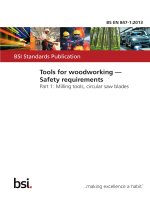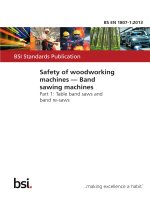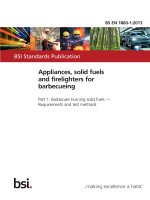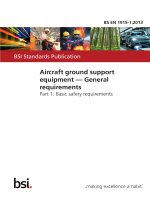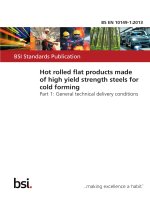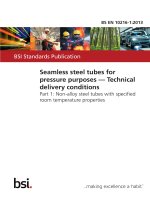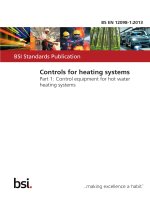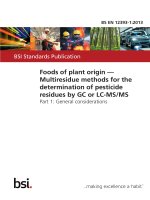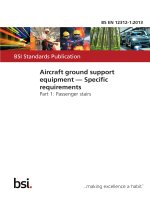Bsi bs en 62246 1 1 2013
Bạn đang xem bản rút gọn của tài liệu. Xem và tải ngay bản đầy đủ của tài liệu tại đây (1.4 MB, 54 trang )
BS EN 62246-1-1:2013
BSI Standards Publication
Reed switches
Part 1-1: Generic specification –
Quality assessment
BRITISH STANDARD
BS EN 62246-1-1:2013
National foreword
This British Standard is the UK implementation of EN 62246-1-1:2013. It
is identical to IEC 62246-1-1:2013. It supersedes DD IEC/PAS 62246-2-1:2008
which is withdrawn.
The UK participation in its preparation was entrusted to Technical
Committee EPL/94, General purpose relays and reed contact units.
A list of organizations represented on this committee can be obtained on
request to its secretary.
This publication does not purport to include all the necessary provisions of
a contract. Users are responsible for its correct application.
© The British Standards Institution 2013.
Published by BSI Standards Limited 2013
ISBN 978 0 580 72741 2
ICS 29.120.70
Compliance with a British Standard cannot confer immunity from
legal obligations.
This British Standard was published under the authority of the
Standards Policy and Strategy Committee on 31 August 2013.
Amendments/corrigenda issued since publication
Date
Text affected
BS EN 62246-1-1:2013
EUROPEAN STANDARD
EN 62246-1-1
NORME EUROPÉENNE
EUROPÄISCHE NORM
August 2013
ICS 29.120.70
English version
Reed switches Part 1-1: Generic specification Quality assessment
(IEC 62246-1-1:2013)
Contacts à lames souples Partie 1-1: Spécification générique Evaluation de qualité
(CEI 62246-1-1:2013)
Reedschalter Teil 1-1: Fachgrundsezifikation –
Qualitätsbewertung
(IEC 62246-1-1:2013)
This European Standard was approved by CENELEC on 2013-06-28. CENELEC members are bound to comply
with the CEN/CENELEC Internal Regulations which stipulate the conditions for giving this European Standard
the status of a national standard without any alteration.
Up-to-date lists and bibliographical references concerning such national standards may be obtained on
application to the CEN-CENELEC Management Centre or to any CENELEC member.
This European Standard exists in three official versions (English, French, German). A version in any other
language made by translation under the responsibility of a CENELEC member into its own language and notified
to the CEN-CENELEC Management Centre has the same status as the official versions.
CENELEC members are the national electrotechnical committees of Austria, Belgium, Bulgaria, Croatia, Cyprus,
the Czech Republic, Denmark, Estonia, Finland, Former Yugoslav Republic of Macedonia, France, Germany,
Greece, Hungary, Iceland, Ireland, Italy, Latvia, Lithuania, Luxembourg, Malta, the Netherlands, Norway, Poland,
Portugal, Romania, Slovakia, Slovenia, Spain, Sweden, Switzerland, Turkey and the United Kingdom.
CENELEC
European Committee for Electrotechnical Standardization
Comité Européen de Normalisation Electrotechnique
Europäisches Komitee für Elektrotechnische Normung
Management Centre: Avenue Marnix 17, B - 1000 Brussels
© 2013 CENELEC -
All rights of exploitation in any form and by any means reserved worldwide for CENELEC members.
Ref. No. EN 62246-1-1:2013 E
BS EN 62246-1-1:2013
EN 62246-1-1:2013
-2-
Foreword
The text of document 94/358/FDIS, future edition 1 of IEC 62246-1-1, prepared by IEC TC 94
"All-or-nothing electrical relays" was submitted to the IEC-CENELEC parallel vote and approved by
CENELEC as EN 62246-1-1:2013.
The following dates are fixed:
•
•
latest date by which the document has
to be implemented at national level by
publication of an identical national
standard or by endorsement
latest date by which the national
standards conflicting with the
document have to be withdrawn
(dop)
2014-03-28
(dow)
2016-06-28
This standard is intended to be used in conjunction with EN 62246-1:2011.
Attention is drawn to the possibility that some of the elements of this document may be the subject of
patent rights. CENELEC shall not be held responsible for identifying any or all such patent rights.
Endorsement notice
The text of the International Standard IEC 62246-1-1:2013 was approved by CENELEC as a European
Standard without any modification.
In the official version, for Bibliography, the following notes have to be added for the standards indicated:
IEC 61810-2-1:2011
NOTE Harmonised as EN 61810-2-1:2011 (not modified).
IEC 60068-2-1:2007
NOTE Harmonised as EN 60068-2-1:2007 (not modified).
IEC 60068-2-2:2007
NOTE Harmonised as EN 60068-2-2:2007 (not modified).
IEC 60068-2-7:1983+A1:1986
NOTE Harmonised as EN 60068-2-7:1993 (not modified).
IEC 60068-2-13:1983
NOTE Harmonised as EN 60068-2-13:1999 (not modified).
IEC 60068-2-17:1994
NOTE Harmonised as EN 60068-2-17:1994 (not modified).
IEC 60068-2-27:2008
NOTE Harmonised as EN 60068-2-27:2009 (not modified).
IEC 60068-2-30:2005
NOTE Harmonised as EN 60068-2-30:2005 (not modified).
BS EN 62246-1-1:2013
EN 62246-1-1:2013
-3-
Annex ZA
(normative)
Normative references to international publications
with their corresponding European publications
The following documents, in whole or in part, are normatively referenced in this document and are
indispensable for its application. For dated references, only the edition cited applies. For undated
references, the latest edition of the referenced document (including any amendments) applies.
NOTE When an international publication has been modified by common modifications, indicated by (mod), the relevant EN/HD
applies.
Publication
Year
Title
EN/HD
Year
IEC 60068-2-6
2007
Environmental testing Part 2-6: Tests - Test Fc: Vibration
(sinusoidal)
EN 60068-2-6
2008
IEC 60068-2-11
+ corr. December
1981
1999
Environmental testing Part 2: Tests - Test Ka: Salt mist
EN 60068-2-11
1999
IEC 60068-2-14
2009
Environmental testing Part 2-14: Tests - Test N: Change of
temperature
EN 60068-2-14
2009
IEC 60068-2-20
2008
Environmental testing EN 60068-2-20
Part 2-20: Tests - Test T: Test methods for
solderability and resistance to soldering heat
of devices with leads
2008
IEC 60068-2-21
+ corr. January
2006
2012
Environmental testing Part 2-21: Tests - Test U: Robustness of
terminations and integral mounting devices
EN 60068-2-21
2006
IEC 60068-2-78
2001
Environmental testing Part 2-78: Tests - Test Cab: Damp heat,
steady state
EN 60068-2-78
IEC 60127-2
2003
Miniature fuses Part 2: Cartridge fuse-links
EN 60127-2
IEC 61373
+ corr. October
2010
2011
Railway applications EN 61373
Rolling stock equipment - Shock and vibration
tests
2010
IEC 62246-1
2011
Reed switches Part 1: Generic specification
2011
1)
EN 62246-1
EN 60068-2-78 is superseded by EN 60068-2-78:2013, which is based on IEC 60068-2-78:2012.
1)
2001
2003
–2–
BS EN 62246-1-1:2013
62246-1-1 © IEC:2013
CONTENTS
INTRODUCTION ..................................................................................................................... 6
1
Scope ............................................................................................................................... 7
2
Normative references ....................................................................................................... 7
3
Terms and definitions ....................................................................................................... 7
4
3.1
3.2
3.3
Test
5
4.1 General ................................................................................................................... 9
4.2 Qualification approval procedures ........................................................................... 9
4.3 Quality conformance inspection ............................................................................... 9
4.4 Formation of inspection lots ..................................................................................... 9
4.5 Intervals between tests ............................................................................................ 9
4.6 Standard conditions for testing ................................................................................ 9
4.7 Mounting of test specimens during the test .............................................................. 9
4.8 General conditions for testing ................................................................................ 10
Characteristic values of the reed switches ...................................................................... 39
Reed switch types ................................................................................................... 8
Tests ....................................................................................................................... 8
Abbreviations .......................................................................................................... 8
schedules ................................................................................................................. 9
5.1
5.2
5.3
6
Characteristics values for general data for reed switches ...................................... 39
Standard test coil number for tests ........................................................................ 40
Contact data .......................................................................................................... 40
5.3.1 Contact reliability, electrical endurance, making and breaking current
capacities and switching frequency ............................................................ 40
5.3.2 Static contact-circuit resistance ................................................................. 45
5.3.3 Mechanical endurance ............................................................................... 45
5.4 Environmental data ............................................................................................... 45
Reliability – Failure rate data .......................................................................................... 46
7
Marking and documentation ............................................................................................ 46
7.1 Marking of the reed switch ..................................................................................... 46
7.2 Marking of the packaging ...................................................................................... 46
Annex A (normative) Mounting in a standard coil ................................................................. 47
Annex B (normative) Variants .............................................................................................. 48
Annex C (informative) Typical applications........................................................................... 49
Bibliography .......................................................................................................................... 50
Figure A.1 – Switch direction and position in a standard coil ................................................. 47
Table 1 – Quality conformance inspection (1 of 8) ................................................................ 11
Table 2 – Tests for qualification approval (1 of 17) ................................................................ 19
Table 3 – Qualification approval (1 of 3) ............................................................................... 36
Table 4 – Characteristic values for general data for reed switches (1 of 2) ............................ 39
Table 5 – Standard test coil number for tests for reed switches............................................. 40
Table 6 – Variant A of reed switches (1 of 3) ........................................................................ 41
Table 7 – Variant B of heavy-duty reed switches ................................................................... 44
BS EN 62246-1-1:2013
62246-1-1 © IEC:2013
–3–
Table 8 – Environmental data for reed switches .................................................................... 45
Table 9 – Reliability data for reed switches ........................................................................... 46
–6–
BS EN 62246-1-1:2013
62246-1-1 © IEC:2013
INTRODUCTION
Reed switches which are in mass production and which are widely used in practice could be
classified by the following characteristics:
a) Size:
–
Normal or standard reed switches with a tube more than 50 mm in length and more
than 5 mm in diameter;
–
Sub-miniature reed switches with a tube more than 20 mm and up to 50 mm in length
and up to 5 mm in diameter;
–
Miniature reed switches with a tube more than 10 mm and up to 20 mm in length and
more than 2 mm and up to 5 mm in diameter;
–
Micro-miniature reed switches with a tube more than 4 mm and up to 10 mm in length
and more than 1,5 mm and up to 5 mm in diameter.
b) Type of switching of electric circuit:
–
Closing or normally open – A type;
–
Opening or normally closed – B type;
–
Changeover – C type.
c) Withstand voltage level:
–
Low-voltage (up to 1 000 V);
–
High-voltage (more than 1 000 V).
d) Switches power:
–
Low-power (up to 60 W);
–
Power (100 to 1 000 W);
–
High-power (more than 1 000 W).
e) Types of electric contacts:
–
The tube is filled with dry air, gas mixture, vacuumized, or high pressurized.
Based on the general provisions of IEC 62246-1, this standard selects and specifies test
procedures for reed switches where enhanced requirements for the verification of quality
assessment specification apply.
This standard describes sampling and test schedules for qualification approval procedures,
quality conformance inspection, formation of inspection lots and intervals between tests.
NOTE
All type of reed switches exclude mercury reed switches.
BS EN 62246-1-1:2013
62246-1-1 © IEC:2013
–7–
REED SWITCHES –
Part 1-1: Generic specification – Quality assessment
1
Scope
This part of the IEC 62246 which is a quality assessment specification defines requirements
and tests to reed switches for use in general and industrial applications.
This standard is intended to be used in conjunction with IEC 62246-1:2011.
This standard selects from IEC 62246-1:2011 and from other sources the appropriate test
procedures to be used in detail specifications derived from this specification.
Reed switch types are specified depending on characteristic values and tests.
NOTE
2
Mercury wetted reed switches are not covered by this standard due to their possible environmental impact.
Normative references
The following documents, in whole or in part, are normatively referenced in this document and
are indispensable for its application. For dated references, only the edition cited applies. For
undated references, the latest edition of the referenced document (including any
amendments) applies.
IEC 60068-2-6:2007, Environmental testing – Part 2-6: Tests – Test Fc: Vibration (sinusoidal)
IEC 60068-2-11:1981, Basic environmental testing procedures – Part 2-11: Tests – Test Ka:
Salt mist
IEC 60068-2-14:2009, Environmental testing – Part 2-14: Tests – Test N: Change of
temperature
IEC 60068-2-20:2008, Environmental testing – Part 2-20: Tests – Test T: Test methods for
solderability and resistance to soldering heat of devices with leads
IEC 60068-2-21:2006, Environmental testing – Part 2-21: Tests – Test U: Robustness of
terminations and integral mounting devices
IEC 60068-2-78:2001, Environmental testing – Part 2-78: Tests – Test Cab: Damp heat,
steady state
IEC 60127-2:2003, Miniature fuses – Part 2: Cartridge fuse-links
IEC 61373:2010, Railway applications – Rolling stock equipment – Shock and vibration tests
IEC 62246-1: 2011, Reed switches – Part 1: Generic specification
3
Terms and definitions
The terms and definitions given in IEC 62246-1:2011, as well as the following, apply.
–8–
3.1
BS EN 62246-1-1:2013
62246-1-1 © IEC:2013
Reed switch types
3.1.1
type
products having similar design features and nominal dimensions manufactured by the same
techniques and falling within a range of ratings specified by the manufacturer
Note 1 to entry:
Mounting accessories are ignored, provided they have no significant effect on the test results.
3.1.2
variant
variation within a type having specific characteristics
3.1.3
reed switch
assembly containing contact blades, partly or completely made of magnetic material,
hermetically sealed in an envelope and controlled by means of an externally generated
magnetic field (e.g. an energizing quantity applied to a coil)
3.1.4
high voltage vacuum reed switch
reed switch, in which ability to switch high voltages is achieved by a high vacuum within the
hermetically sealed envelope
3.1.5
heavy-duty reed switch
reed switch, in which greater switching capacity is achieved
Note 1 to entry: Blades having additional contact tips or a contact tip and spring which separate the magnetic
path and electric path are typical examples of techniques to increase switching capacity.
3.2
Tests
3.2.1
routine test
conformity test made on each reed switch during or after manufacture
3.2.2
lot-by-lot test
test carried out periodically on a sample of reed switches drawn from running production at
least once a month
3.2.3
periodic test
test carried out periodically on a sample of reed switches drawn from running production at
least once a year and every two years
Note 1 to entry:
maintained.
3.3
The results from periodic tests are used verify that the level of technical performance is
Abbreviations
3.3.1
IL
inspection level
inspection level which determines the relationship between the lot or batch size and the
sample size
Note 1 to entry:
The size of the sample drawn from the lot is dependent on the severity of the inspection level.
BS EN 62246-1-1:2013
62246-1-1 © IEC:2013
–9–
3.3.2
AQL
acceptance quality level
maximum percent defective that can be considered satisfactory as a process average
4
Test schedules
4.1
General
Test procedures are referenced in the corresponding subclauses of IEC 62246-1:2011.
4.2
Qualification approval procedures
–
Sampling and test schedule are specified in Table 2 and Table 3.
–
The tests specified and their order is mandatory.
–
Tests stated in Table 2 and 3 are mandatory for the variants except when otherwise
specified.
4.3
Quality conformance inspection
An initial conformity test has to be passed and then confirmed by routine tests, lot-by-lot tests
and periodic tests.
Quality conformance inspection contains the tests stated in Table 1:
–
Group A: routine tests;
–
Groups A and B: lot-by-lot tests;
–
Group C: periodic tests.
Unless otherwise stated in this specification, all tests of Table 1 are mandatory.
Where a subgroup contains cumulative tests, the order of the tests is mandatory. Specimens
that have been subjected to tests denoted as destructive (D) shall not be released for delivery.
Specimens that have been subjected to tests denoted as non-destructive (ND) are permitted
to be released for delivery.
4.4
Formation of inspection lots
The basis for determination of sample size for the quality conformance inspection is the reed
switch quantity produced during one month.
4.5
Intervals between tests
– Subgroup A0:
at shipment.
– Subgroups A4 and B1:
at least once a month.
– Subgroups C1:
at least once a year.
– Subgroup C4:
at least once every two years.
4.6
Standard conditions for testing
If not otherwise stated, all tests shall be performed under standard conditions for testing
according to 7.3 of IEC 62246-1:2011.
4.7
Mounting of test specimens during the test
The following requirement shall apply for shock and vibration tests:
– 10 –
BS EN 62246-1-1:2013
62246-1-1 © IEC:2013
The reed switch shall be mounted by its normal mounting method to the test fixture, where
inherent resonances have been minimized so as not to invalidate the test.
4.8
General conditions for testing
Unless otherwise stated, the test coil number and when applicable its polarity specified in
Table 5 shall be used for all tests. Unless otherwise stated in this specification, the polarity
shall be as specified by the manufacturer.
BS EN 62246-1-1:2013
62246-1-1 © IEC:2013
– 11 –
Table 1 – Quality conformance inspection (1 of 8)
Group A
Subgroup A0
For all tests in this subgroup:
Test
no.
Test
100 % test.
Test conditions according to
IEC 62246-1:2011
A0 – 1
Visual inspection and
check of dimensions
(ND)
Subclause 7.4
A0 – 2
Functional tests (ND)
Subclause 7.5, Procedure 1
Performance
requirements
According to Table 4
Marking as specified in 7.1
Application points and standard test coil number:
According to Table 5
must-operate value:
saturate value: 150 % of must-operate
must-release value:
According to Table 4
Contact failure-to-make and failure-to-break by
monitoring a current, typically
10 mA at 24 V DC max.
A0 – 3
Contact circuit
resistance (ND)
Subclause 7.7
Initial value according to Table 4
Application points:
terminals of closed
contacts
Standard test coil number:
According to Table 5
Test coil voltage: 150 % of must-operate
Test voltage max.:
6 V DC or 6 V AC
Test current max.:
1 A
A0 – 4
Dielectric test (ND)
Subclause 7.8
Application points and test voltage:
According to Table 4
Duration of test: 1 min
Maximum leakage current:
0,5 mA
NOTE A shorter test with a higher voltage can be
stated in the detail specification.
A0 – 5
Operating times (ND)
Subclause 7.10
Application points and standard test coil number:
Test coil voltage:
According to Table 5
150 % of must-operate
1) operate time
2) release time
3) operate bounce time
According to Table 4
Contact failure-to-make and failure-to-break by
monitoring a current, typically 10 mA at 24 V DC
max.
A0 – 6
Sealing (ND)
Subclause 7.21
Application points and standard test coil number:
According to Table 5
Arc time during test for heavy-duty reed switches:
According to Table 7
Test coil voltage: 150 % of must-operate
Test voltage: 100 V DC – 110 V DC
Test current: 0,5 A – 0,55 A
Total number of operations required: 3
Leak test for reed switches and high voltage reed
switch.
– 12 –
BS EN 62246-1-1:2013
62246-1-1 © IEC:2013
Table 1 (2 of 8)
Subgroup A4 (period: inspection lot refers to the production volume in one month)
Test
no.
1
2
Test
Test conditions according to
IEC 62246-1:2011
Visual inspection and
check of dimensions
(ND)
Subclause 7.4
Functional tests (ND)
Subclause 7.5, Procedure 1
IL
AQL
Performance
requirements
According to Table 4
Marking as specified
in 7.1
Application points and standard test coil number:
According to Table 5
must-operate value
saturate value: 150 % of must-operate
must-release value
According to Table 4
Contact failure-to-make and failure-to-break by monitoring
a current, typically 10 mA at 24 V DC max.
3
Contact-circuit
resistance (ND)
Subclause 7.7
Initial value according
to Table 4
Application points:
terminals of closed contacts
Standard test coil number:
Test coil voltage: 150 % of must-operate
Test voltage max. 6 V DC or 6 V AC
Test current max.: 1 A
4
Dielectric test (ND)
Subclause 7.8
Operating times (ND)
S4
1,0
Application points and test voltage:
According to Table 4
Duration of test: 1 min
Maximum leakage
current:
0,5 mA
NOTE A shorter test with a higher voltage can be stated in
the detail specification.
5
According to Table 5
Subclause 7.10
Application points and standard test coil number:
According to Table 5
Test coil voltage: 150 % of must-operate
1) operating time
2) release time
3) operate bounce time
According to Table 4
Contact failure-to-make and failure-to-break by monitoring
a current, typically 10 mA at 24 V DC max.
6
Sealing (ND)
Subclause 7.21
Application points and standard test coil number:
Arc time during test for heavy-duty reed switches:
Test coil voltage: 150 % of must-operate
Test voltage: 100 V DC – 110 V DC
Test current: 0,5 A – 0,55 A
Total number of operations required: 3
Leak test for reed switches and high-voltage vacuum reed
switch.
According to Table 5
According to Table 7
BS EN 62246-1-1:2013
62246-1-1 © IEC:2013
– 13 –
Table 1 (3 of 8)
Subgroup B1 (period: inspection lot refers to the production volume of one month)
Test
no.
7
Test
Contact reliability test
(D)
Test conditions according to
IEC 62246-1:2011
Subclause 7.28
Test switch type and standard test coil
number:
IL
AQL
S3
2,5
Performance
requirements
According to Table 5
Test coil voltage: 150 % of must-operate
Coil suppression: N/A
Duty cycle:
50 %
Switching load conditions:
According to Table 6
Monitoring conditions:
According to Table 6
At each cycle during the test
Final measurements:
Test 3 – contact circuit resistance
According to Table 4
Test 2 – functional tests
According to Table 4
BS EN 62246-1-1:2013
62246-1-1 © IEC:2013
– 14 –
Table 1 (4 of 8)
Subgroup C1 (period: one year)
Test
no.
8
Test
Robustness of
terminals (D)
Test conditions according to
IEC 62246-1:2011
Subclause 7.12 (in accordance with
IEC 60068-2-21:2006)
Sample
size
Acceptable
number of
failures
Performance
requirements
6
0
According to Table 4
No breaking or loosening of
terminals
Procedure: test Ua1 – tensile
Final measurements:
9
Soldering (D)
Test 1 – visual inspection
No cracks or other
deterioration
Test 2 – functional tests
According to Table 4
Test 6 – sealing
According to Table 7
Subclause 7.13 (in accordance with
IEC 60068-2-20:2008, test Ta, method 1)
Temperature:
(250 ± 5) °C
Duration:
(2 ± 0,5) s
Application point: 5 mm from the glassto-metal seals
5
0
The dipped surface shall be
95 % covered with new
solder coating, the
remaining 5 % may contain
only small pinholes
Subclause 7.13 (in accordance with
IEC 60068-2-20:2008, test Ta, method 2)
Temperature:
(350 ± 5) °C
Duration:
(3 ± 0,5) s
Application point: 5 mm from the glassto-metal seals
Final measurements:
Test 1 – visual test
No cracks or other
deterioration
Test 2 – functional tests
According to Table 4
Test 6 – sealing
According to Table 7
BS EN 62246-1-1:2013
62246-1-1 © IEC:2013
– 15 –
Table 1 (5 of 8)
Subgroup C1 (period: one year)
Test
no.
10
Test
Rapid change of
temperature (D)
Test conditions according to
IEC 62246-1:2011
Subclause 7.16 (in accordance with
IEC 60068-2-14:2009)
Sample
size
Acceptable
number of
failures
6
0
Performance
requirements
Low temperature:
– 50 °C for heavy-duty reed switches
– 40 °C for reed switches and high
voltage vacuum reed switch
Temperature:
100 °C for heavy-duty reed switches
125 °C for reed switches and high
voltage vacuum reed switch
Exposure time:
20 min for heavy-duty reed switches
30 min for reed switches and high
voltage vacuum reed switch
Transition time:
1 min for heavy-duty reed switches
15 min for reed switches and high
voltage reed switch
Number of cycles:
10 for heavy-duty reed switches
5 for reed switches and high voltage
vacuum reed switch
Final measurements:
Test 4 – dielectric test
Test 2 – functional tests
Test 3 – contact circuit resistance
Test 1 – visual inspection
Test 6 – sealing test
According to Table 4
No cracks or other
deterioration
According to Table 7
According to Table 4
According to Table 7
BS EN 62246-1-1:2013
62246-1-1 © IEC:2013
– 16 –
Table 1 (6 of 8)
Subgroup C1 (period: one year)
Test
no.
11
Test
Vibration (D)
Functional
Test conditions according to
IEC 62246-1:2011
Subclause 7.18
Sample
size
Acceptable
number of
failures
6
0
Test switch type and standard test coil
number: according to Table 5
Test coil voltage: 150 % of must-operate
Axis of mounting:
Performance
requirements
No opening of closed
contact circuit with
energization condition or
closing of opened contact
circuit shall exceed 10 µs
The movable contact shall
be located in the transverse
direction
Vibration conditions:
Application:
three directions
Number of sweeps per direction: 3
Sweep rate:
1 octave/min ± 10 %
Total duration:
approx. 3 × 10 min
According to Table 7
Test contact voltage and current:
24 V DC max., 10 mA max.
Final measurements:
12
Electrical
endurance (D)
Test 1 – visual inspection
No cracks or other
deterioration
Test 2 – functional tests
According to Table 4
Test 6 – sealing
According to Table 7
Subclause 7.22
6
0
Test switch type and standard test coil
number:
Test coil voltage: 150 % of must-operate
Coil suppression:
N/A
Duty cycle:
50 %
According to Table 5
Switching load conditions:
According to Table 6
Monitoring conditions:
According to Table 6
At each cycle during the
test
Final measurements:
Test 3 – contact circuit resistance
According to Table 4
If applicable:
Test 2 – functional tests
According to Table 4
Test 4 – dielectric test
According to Table 4
BS EN 62246-1-1:2013
62246-1-1 © IEC:2013
– 17 –
Table 1 (7 of 8)
Subgroup C4 (period: at least once every two years)
Test
no.
13
Test
Shock (D)
Functional
Test conditions according to
IEC 62246-1:2011
Subclause 7.19
Sample
size
Acceptable
number of
failures
6
0
Test switch type and standard test coil
number: According to Table 5
Test coil voltage: 150 % of must-operate
Axis of mounting:
Performance
requirements
No opening of closed
contact circuit with
energization condition, or
closing of opened contact
circuit shall exceed 10 µs
The movable contact shall
be located in the transverse
direction
Shock conditions:
Application: three directions
Number of shocks: 18 (three positive and
three negative in each of the three
orthogonal planes)
Duration: 11 ms
According to Table 7
Test contact voltage and current:
24 V DC max., 10 m A max.
Final measurements:
14
Mechanical
endurance (D)
Test 1 – visual inspection
No cracks or other
deterioration
Test 2 – functional tests
According to Table 4
Test 6 – sealing
According to Table 7
Subclause 7.23
Test switch type and standard test coil
number:
Test coil voltage: 150 % of must-operate
Coil suppression: N/A
Duty cycle:
50%
Number of cycles per s:
50 to 60
20
1
There shall be no broken
parts
According to Table 5
Periodic
measurements:
6
6
6
6
1×10 7 ; 3×10 7 ; 5×10 7 ; 7×10 7 ;
8
1×10 ; 3×10 ; 5×10 ; 7×10 ;and 10
Limits for failure to make:
±20 % change of mustoperate value for heavyduty reed switches
±15 % change of mustoperate value for reed
switches
Limits for failure to break:
50 % change of mustrelease value for heavyduty reed switches
30 % change of mustrelease value for reed
switches
Test 3 – contact circuit resistance
According to Table 4
Test 2 – functional tests
According to Table 4
BS EN 62246-1-1:2013
62246-1-1 © IEC:2013
– 18 –
Table 1 (8 of 8)
Subgroup C4 (period: at least once every two years)
Test
no.
15
Test
Test conditions according to
IEC 62246-1:2011
Making current
capacity test (D)
Subclause 7.30
Heavy-duty reed
switches only
Test coil voltage: 150 % of must-operate
Coil suppression: N/A
Sample
size
Acceptable
number of
failures
6
0
Performance
requirements
According to Table 5
Test switch type and standard test coil
number:
Making load conditions:
According to Table 6
Monitoring conditions:
monitoring times: t 1 = 400 ms,
At each cycle during the
test
Test 3 – contact circuit resistance
According to Table 4
If applicable:
Test 2 – functional tests
According to Table 4
τ1 = 50 ms
Test 4 – dielectric test
16
Breaking current
capacity test (D)
Subclause 7.31
Heavy-duty reed
switches only
Test coil voltage: 150 % of must-operate
Coil suppression: N/A
According to Table 4
6
0
According to Table 5
Test switch type and standard test coil
number:
Breaking load conditions:
According to Table 6
Monitoring conditions:
monitoring times: t 2 = 400 ms,
At each cycle during the
test
Test 3 – contact circuit resistance
According to Table 4
If applicable:
Test 2 – functional tests
According to Table 4
Test 4 – dielectric test
According to Table 4
τ2 = 50 ms
17
Surge withstand
test (D)
Variant B of
heavy-duty reed
switches only
Subclause 7.25
test voltage:
3 000 V
test voltage wave form:
1,2/50 µs
number of pulses:
6 pulses
(three positive and three negative)
3
0
According to Table 6
Final measurements:
Test 1 – visual test
No cracks or other
deterioration
Test 2 – functional tests
According to Table 4
Test 4 – dielectric test
According to Table 4
BS EN 62246-1-1:2013
62246-1-1 © IEC:2013
– 19 –
Table 2 – Tests for qualification approval (1 of 17)
Test
no.
Test
1
Visual inspection
and check of
dimensions (ND)
Subclause 7.4
2
Functional tests
(ND)
Subclause 7.5, Procedure 1
Test conditions according to
IEC 62246-1:2011
Sample
size
Acceptable
number of
failures
Performance
requirements
According to Table 4
Marking as specified in 7.1
Application points and standard test coil
number:
According to Table 5
must-operate value:
saturate value: 150 % of must-operate
must-release value:
According to Table 4
Contact failure-to-make and failure-tobreak by monitoring a current, typically
10 mA at 24 V DC max.
3
4
Contact circuit
resistance (ND)
Dielectric test
(ND)
Subclause 7.7
Application points:
terminals of
closed contacts
Standard test coil number:
Test coil voltage: 150 % of must-operate
Test voltage max. 6 V DC or 6 V AC
Test current max.: 1 A
Operating times
(ND)
According to Table 5
Subclause 7.8
According to Table 4
Maximum leakage current:
0,5 mA
Application points and test voltage:
Duration of test:
1 min
NOTE A shorter test with a higher
voltage can be stated in the detail
specification.
5
Initial value according to
Table 4
170
0
Subclause 7.10
Application points and standard test coil
number:
According to Table 5
Test coil voltage: 150 % of must-operate
operate time:
release time:
operate bounce time:
According to Table 4
Contact failure-to-make and failure-tobreak by monitoring a current, typically
10 mA at 24 V DC max.
6
Sealing (ND)
Subclause 7.21
Application points and standard test coil
number:
According to Table 5
Arc time during test for heavy-duty reed
switches
According to Table 7
Test coil voltage: 150% of must-operate
Test voltage: 100 V DC – 110 V DC
Test current: 0,5 A – 0,55 A
Total number of operations required: 3
Leak test for reed switches and high
voltage vacuum reed switch.
BS EN 62246-1-1:2013
62246-1-1 © IEC:2013
– 20 –
Table 2 (2 of 17)
Test
no.
Test
7
Remanence tests
(ND)
Test conditions according to
IEC 62246-1:2011
Subclause 7.6
Acceptable
number of
failures
6
0
According to Table 5
saturate value: 150 % of must-operate
just-operate value 1
saturate value (reverse polarity): 150% of
must-operate
just-operate value 2
Remanence value: Max.
10%
Insulation test
(ND)
Subclause 7.9
9
Contact sticking
(ND)
Thermal sticking
Subclause 7.11.1, Procedure 1
Application points and standard test coil
number:
upper category temperature:
150 °C for heavy-duty reed switches
125 °C for reed switches
saturate value: 150 % of must-operate
test period:
min 24 h
max. permitted value:
6
0
6
0
According to Table 4
Application points and test voltage:
Robustness of
terminals (D)
Subclause 7.11.2
Application points and standard test coil
number:
Subclause 7.12 (in accordance with
IEC 60068-2-21:2006)
Procedure: test Ua1 – tensile
According to Table 5
Permitted value: max.10 %
According to Table 5
pulsing rate: 10 cycles per second
limits for the peak-to-peak value of the
pulse: 200 % and 100 % of must-operate
number of test cycles:
5
min. contact circuit resistance defining
failure-to-break:
10
Performance
requirements
Application points and standard test coil
number:
8
Magnetostrictive
sticking
Sample
size
Zero failure-to-break
According to Table 4
6
0
According to Table 4
No breaking or loosening of
terminals
Final measurements:
Test 1 – visual inspection
No cracks or other
deterioration
Test 2 – functional tests
According to Table 4
Test 6 – sealing
According to Table 7
BS EN 62246-1-1:2013
62246-1-1 © IEC:2013
– 21 –
Table 2 (3 of 17)
Test
no.
11
Test
Soldering (D)
Test conditions according to
IEC 62246-1:2011
Subclause 7.13 (in accordance with
IEC 60068-2-20:2008, test Ta, method 1)
Temperature:
Duration:
Application point:
glass-to-metal seals
(250 ± 5) °C
(2 ± 0,5) s
5 mm from the
Sample
size
Acceptable
number of
failures
6
0
Performance
requirements
When inspected with a
magnifying lens the dipped
surface shall be 95 %
covered with new solder
coating, the remaining 5 %
may contain only small
pinholes
Subclause 7.13 (in accordance with
IEC 60068-2-20:2008, test Ta, method 2)
Temperature:
(350 ± 5) °C
Duration:
(3 ± 0,5) s
Application point:
5 mm
from the glass-to-metal seals
Final measurements:
Test 1 – visual test
No cracks or other
deterioration
Test 2 – functional tests
According to Table 4
Test 6 – sealing
According to Table 7
BS EN 62246-1-1:2013
62246-1-1 © IEC:2013
– 22 –
Table 2 (4 of 17)
Test
no.
12
Test
Climatic
sequence (D)
Test conditions according to
IEC 62246-1:2011
Subclause 7.14
Sample
size
Acceptable
number of
failures
6
0
Performance
requirements
Dry heat, 7.14.2 of IEC 62246-1:2011
Application points and standard test coil
number:
Temperature:
200 °C for heavy-duty reed switches
125 °C for reed switches and high voltage
vacuum reed switch
According to Table 5
Value according to Table 7
Duration:
16 h
Recovery:
4 h
During the last 2 h of dry heat exposure:
monitoring of contact-circuit resistance
Number of cycles per s:
2
Duty factor:
1:1
Test contact voltage: max. 6 V DC or AC
Test contact current: max. 1 A
Before the end of dry heat exposure:
Test 2 – functional tests
Damp heat cyclic, 7.14.2 of IEC 622461:2011, one cycle
Temperature
55 °C
Recovery:
4 h
Cold, 7.14.2 of IEC 62246-1:2011
Temperature:
– 50 °C for heavy-duty reed switches
– 40 °C for reed switches and high voltage
vacuum reed switch
Duration:
Value according to Table 7
2 h
Before the end of cold exposure:
Test 2 – functional tests
Damp heat cyclic, 7.14.2 of IEC 622461:2011, one cycle
Temperature:
55 °C
Recovery:
4 h
Final measurements:
Test 4 – dielectric test
According to Table 4
Test 2 – functional tests
According to Table 4
Test 3 – contact-circuit resistance
According to Table 4
Test 1 – visual inspection
No cracks or other
deterioration
Test 6 – sealing test
According to Table 7
BS EN 62246-1-1:2013
62246-1-1 © IEC:2013
– 23 –
Table 2 (5 of 17)
Test
no.
13
Test
Damp heat,
steady state
(D)
Test conditions according to
IEC 62246-1:2011
Subclause 7.15 (in accordance with
IEC 60068-2-78:2001)
Sample
size
Acceptable
number of
failures
6
0
Performance
requirements
Temperature:
200 °C for heavy-duty reed switches
125 °C for reed switches and high voltage
vacuum reed switch
Conditioning time:
10 days
Final measurements:
Test 4 – dielectric test
According to Table 4
Test 2 – functional tests
According to Table 4
Test 3 – contact circuit resistance
According to Table 4
Test 1 – visual inspection
No cracks or other
deterioration
Test 6 – sealing test
According to Table 7
Test 11 – solderability
14
Rapid change
of
temperature
(D)
Subclause 7.16 (in accordance with
IEC 60068-2-14:2009)
Low temperature:
High temperature:
Exposure time:
Transition time:
Number of cycles:
6
0
– 50 °C
100 °C
20 min
1 min
10
Final measurements:
Test 4 – dielectric test
Test 2 – functional tests
Test 3 – contact-circuit resistance
Test 1 – visual inspection
Test 6 – sealing test
According to Table 4
According to Table 4
According to Table 4
No cracks or other
deterioration
According to Table 7
